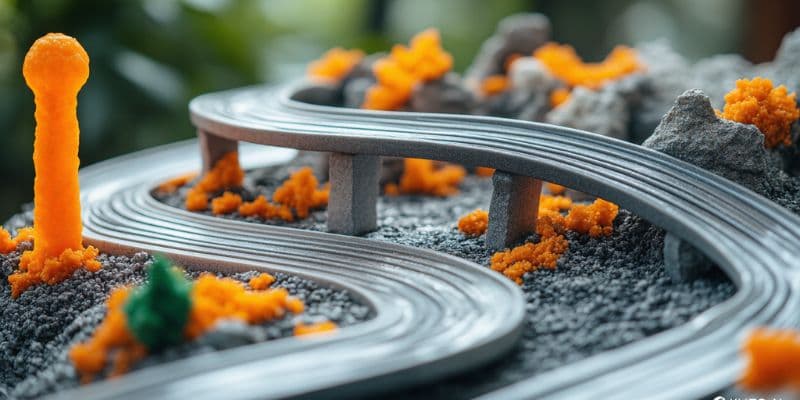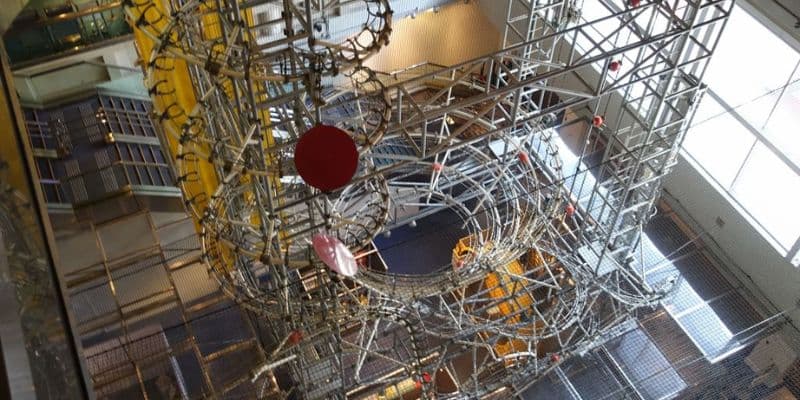Ready to turn your marble run into a high-octane speedway? Optimizing marble track speed is a thrilling blend of science, engineering, and a touch of magic. With a few simple tweaks, you can transform your track into a gravity-powered raceway where marbles whiz by at lightning speeds.
In the following guide, We will explore further the factors that influence marble speed, offering insights and strategies to help you optimize your track for maximum velocity. Get ready to unleash your inner engineer and create a marble run faster than ever!
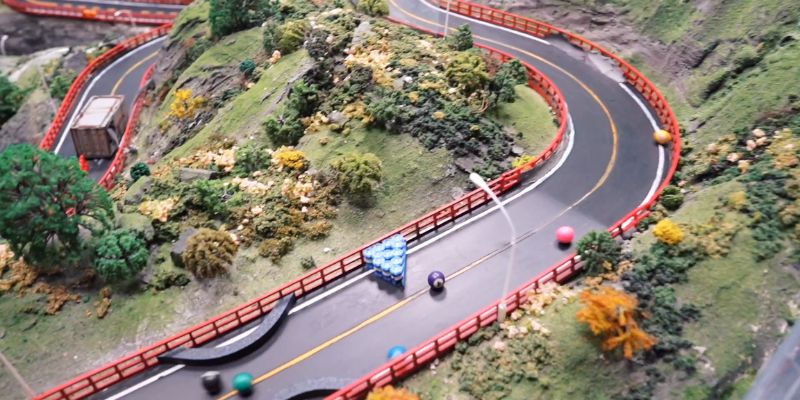
The science behind marble racing speed
Understanding the science behind those rolling spheres can help you design faster tracks, choose the right marbles, and strategize for victory. Let’s delve into the fascinating forces that propel marbles to their limits.
Gravity: The Driving Force
Gravity is the key player in marble racing, pulling the marbles down the track and accelerating them as they go. The steeper the slope, the stronger the gravitational force, resulting in faster speeds.
Due to its position at the top of a ramp, a marble possesses potential energy. As it descends, this potential energy converts into kinetic energy, the energy of motion. Gravity and the slope angle determine the rate at which a marble accelerates, with steeper slopes leading to quicker acceleration.
Friction: The Necessary Resistance
Friction is the force that opposes motion between two surfaces in contact, and it plays a crucial role in marble racing. It controls the marbles’ movement and prevents them from flying off the track. There are two main types of friction in marble racing: static friction, which prevents a stationary marble from starting to move, and kinetic friction, which resists the motion of a moving marble.
The surface material, marble material, and contact area all affect friction. Smooth surfaces like plastic create less friction than rough surfaces, and glass marbles are smoother than steel or ceramic ones.
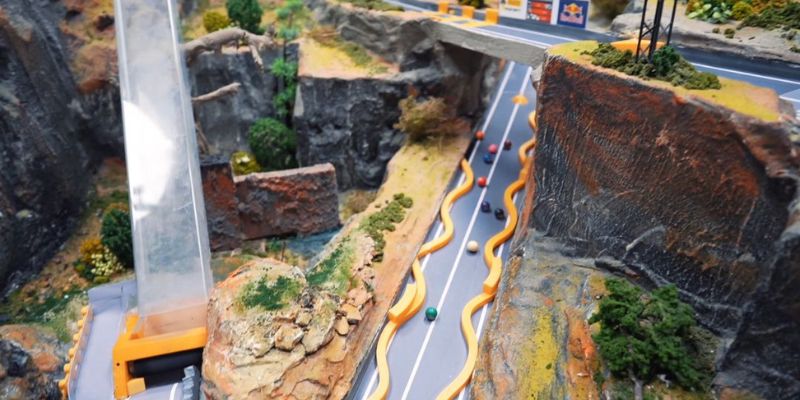
Momentum: The Power of Mass and Velocity
Momentum is the product of a marble’s mass and velocity, essentially the “oomph” it has as it rolls down the track. Heavier marbles, or those moving at higher speeds, have more incredible momentum, helping them maintain speed and overcome obstacles.
In races with multiple marbles, momentum determines the outcome of collisions, with marbles having more incredible momentum pushing lighter or slower marbles out of the way.
Air Resistance: The Unseen Braking Force
Air resistance, or drag, opposes the motion of objects through the air. While it might not be as noticeable as gravity or friction, it does affect marble speed, especially at high velocities. Factors affecting air resistance include speed (faster marbles experience more resistance), shape (streamlined shapes like spheres experience less resistance), and size (larger marbles with a more significant surface area experience more resistance).
By understanding these physics concepts and their interaction, you can design a marble run that optimizes speed and delivers thrilling races. Experiment with different track designs, marble materials, and sizes to find the perfect combination for your gravity-powered masterpiece.
Design tips for optimizing marble track speed
Transform your marble run into a high-speed haven where marbles blaze down the track with exhilarating velocity. By applying these design tips and understanding the physics of speed, you can optimize your track for maximum thrills and create races that leave spectators on the edge of their seats.
The Art of the Angle: Mastering Ramp Design
The angle of your ramps is crucial in determining a marble’s speed. Steeper ramp angles mean stronger gravitational pull, leading to faster acceleration and higher speeds. A starting ramp angle of 30 to 45 degrees for most tracks balances quick acceleration and maintaining control.

Experiment with different angles to find the sweet spot for your marbles and track design. As the race progresses, gradually decrease the ramp angles to maintain momentum while preventing the marbles from flying off the track at high speeds. Don’t limit yourself to straight ramps; experiment with curved, multi-level, and spiral ramps for added excitement and visual appeal.
Smooth Operator: Minimizing Friction
Friction is the force that resists motion and slows down your marbles. Minimizing friction is key to achieving top speeds on your track. Opt for materials with low friction coefficients, such as smooth plastic tubes, polished wood, or metal tracks.
Tape or glue secures connections and eliminates bumps or gaps, ensuring smooth transitions between track sections. Regularly clean your track with a soft cloth or brush to maintain optimal speed by removing dust, debris, and fingerprints.
Momentum Masters: Harnessing the Power of Motion
Momentum is your marble’s secret weapon for maintaining speed and conquering obstacles. Incorporate long, straight sections into your track to allow marbles to build up momentum before encountering obstacles.
Design banked curves to help marbles maintain speed while turning. Use gravity to your advantage by incorporating strategic downhill sections that give marbles a burst of speed.
Streamline Your Design: Efficiency for Speed
A well-designed track should be efficient, minimizing unnecessary detours and obstacles that could slow down the marbles. Opt for the most direct path from start to finish, avoiding excessive curves or lengthy detours.
While obstacles add excitement, too many can hinder speed, so place them strategically to create challenges without significantly slowing down the marbles. A more compact track with a streamlined layout can lead to faster race times.
Air Resistance: Don’t Forget the Invisible Force
Air resistance, also known as drag, can slow down your marbles, especially at high speeds. Choose marbles with aerodynamic shapes, like spheres or teardrops to minimize air resistance. Avoid sharp angles or sudden drops in your track design that can cause the marbles to tumble and increase air resistance. Be mindful of environmental factors such as wind and humidity, as these can affect air resistance and alter the marble’s behavior.
By understanding and applying these concepts, you can design a marble run that maximizes speed and delivers thrilling races. Experiment with different track designs, materials, and marble shapes to find the perfect combination for your high-speed marble racing masterpiece.
How marble materials affect the speed
In the high-stakes world of marble racing, every fraction of a second counts. While track design plays a significant role, the type of marble you choose can be the ultimate game-changer. Let’s explore how different marble materials can influence speed and help you achieve victory.
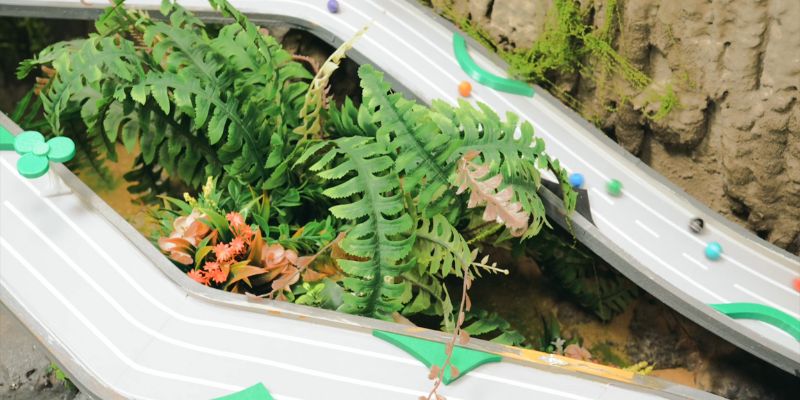
Glass Marbles: The Lightweight Speedsters
Glass marbles are a classic choice for marble racing. They are celebrated for their smooth surface, vibrant colors, and affordability. Due to their low friction, glass marbles glide effortlessly on soft tracks, allowing them to achieve impressive speeds.
Their lightweight nature gives them quick acceleration, making them ideal for short races or tracks with rapid changes in direction. However, glass marbles are fragile and can chip or crack on rougher surfaces or during high-impact collisions.
Steel Marbles: The Momentum Masters
Steel marbles are the heavyweights of the marble world, known for their durability and ability to maintain momentum. Their high density allows them to build significant momentum and maintain high speeds even on long straightaways or after encountering obstacles. They are incredibly durable and resistant to chipping, making them a popular choice for intense races and tracks with high-impact elements.
Some steel marbles are magnetic, offering possibilities for interactive tracks that utilize magnetic forces for propulsion or redirection. However, their heavier weight means slower acceleration, which can be a disadvantage on tracks with frequent starts and stops.
Ceramic Marbles: The Best of Both Worlds
Ceramic marbles offer a unique combination of speed and durability, making them versatile for various tracks. Their smooth, polished surface minimizes friction, allowing for high speeds on soft and textured tracks.
Ceramic marbles are more resistant to chipping and cracking than glass, although not as tough as steel. They are often handcrafted and feature beautiful designs and patterns, adding an artistic touch to the race.
Beyond the Basics: Exploring Alternative Materials
While glass, steel, and ceramic are the most popular choices, other materials can also be considered:
Agate Marbles: Known for their unique patterns and colors, agate marbles are popular among collectors. However, their rougher surface can create more friction, affecting speed and predictability.
Plastic Marbles: Lightweight and affordable, plastic marbles are ideal for younger children or casual play. However, they are less durable, and their movement can be more unpredictable than other materials.
Wooden Marbles: Some enthusiasts create wooden marbles, adding a personalized touch to their races. Wooden marbles can vary in weight and texture, offering unique performance characteristics.
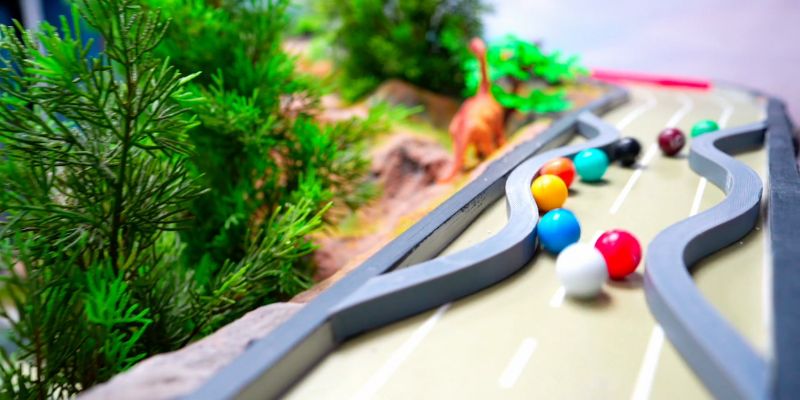
Choosing the Right Marble: Factors to Consider
Selecting the perfect marble for your race depends on several factors. Consider the track type and material—smooth or rough, wood, plastic, or metal. Different race formats, like sprints, endurance races, or obstacle courses, may favor different marble materials and sizes. Ultimately, the best marble is the one you enjoy racing with, so experiment with different types to discover your preferences and strategies.
By understanding the characteristics of various marble materials, you can choose the ideal marble to optimize your track’s performance and enhance your racing experience.
Additional Tips for Speed Optimization
Mastering the fundamentals of marble selection and track design is crucial, but there are additional tips and tricks for optimizing your marble run for speed and achieving those exhilarating, record-breaking races. Let’s explore these strategies that can give your marbles an extra boost.
Lubrication: A Slippery Slope to Success
In marble racing, lubrication can significantly reduce friction between the marble and the track, allowing faster speeds and smoother runs. However, overdoing it can make the track slippery, leading to unpredictable outcomes. Common lubricants for marble runs include graphite powder and silicone spray.
Graphite powder is often preferred for its dry application, reducing friction without making the track overly slick. Apply lubricant sparingly to areas where marbles slow down or experience excessive friction, such as curves or high-friction track materials like wood. Avoid applying lubricant to ramps or areas where you want the marbles to maintain control and grip, as excessive lubrication can make the track too slippery and difficult to navigate.
Cleaning and Maintenance: Keeping Your Track in Tip-Top Shape
A clean and well-maintained track is essential for optimal marble speed. Dust, debris, and fingerprints can create friction and slow your marbles. Regularly wipe down your track with a soft cloth or brush to remove dust and debris.
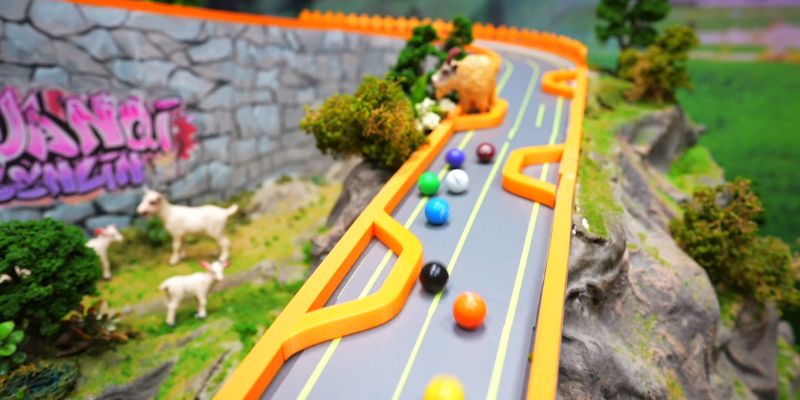
For a more thorough cleaning, use a mild detergent and water solution to remove stubborn dirt or grime, ensuring the track is completely dry before racing. Regularly inspect your track for any signs of wear and tear, such as warped pieces, loose connections, or damaged obstacles, and address these issues promptly to ensure smooth marble movement.
Environmental Factors: Playing by Nature’s Rules
The environment can also affect marble speed. Warmer temperatures can slightly decrease friction, leading to faster speeds, but extreme heat can warp certain track materials, so be mindful of where you place your marble run.
High humidity can create a thin layer of moisture on the track, increasing friction and potentially slowing down your marbles. Wind can affect lightweight marbles, especially on outdoor tracks. If you’re racing outdoors, consider wind direction and adjust your track layout or marble selection accordingly.
Experiment and Refine: The Pursuit of Perfection
Optimizing your marble track for speed is an ongoing process. Don’t be afraid to experiment with different combinations of track designs, materials, marbles, and even lubrication. Keep track of your results and make adjustments as needed.
By continuously testing and refining your creations, you’ll understand the factors influencing marble speed and develop your unique techniques for building the fastest and most exciting marble race tracks.









